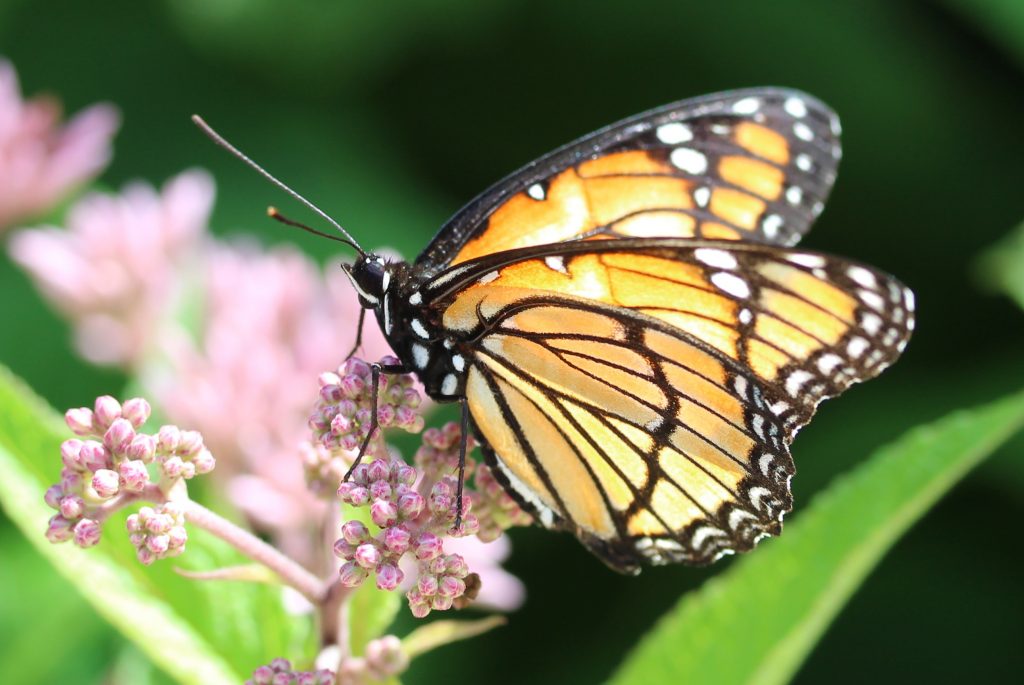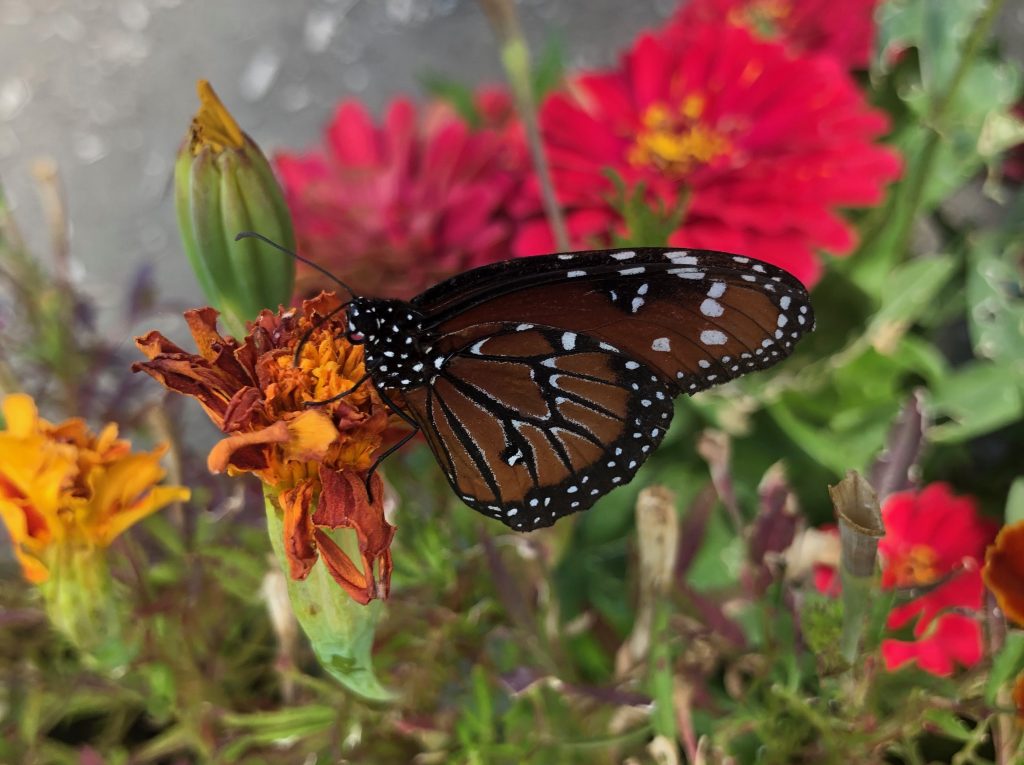From the Hort Desk
- 2021-09-05
- By mkirk
- Posted in The Garden Buzz
The Amazing Monarch Butterfly
By Lisa Mason, CSU Extension Horticulture Agent
Monarch butterflies are an iconic species in the United States. These bright orange and black butterflies are known for their migration in North America. How do these small creatures make the 3,000-mile journey every year?
Identification
While the bright orange butterflies can be hard to miss, Colorado has a variety of orange-colored butterflies. You can identify a monarch butterfly by the black veins on the wings in addition to the bright orange color. They also have white spots on the edges of the wings. The wingspan usually ranges from 3-4 inches long. You can identify where the butterfly is a male or female by looking at the hind wing. If the butterfly is a male, it will have one black spot on each hind wing along one of the center veins. If the butterfly is female, she will not have a spot.
Monarch caterpillars have contrasting black, yellow, and white stripes on their bodies. Caterpillar size varies depending on what instar, or stage of growth the caterpillar is in.

Life Cycle
All butterflies, including monarchs, go through a lifecycle called metamorphosis that includes an egg, caterpillar, a pupa called a chrysalis, and an adult butterfly. When monarchs are caterpillars, their job is to feed as much as possible. They feed exclusively on milkweed plants (Asclepias spp.). Look for caterpillars with white, yellow, and black stripes. Once they have fully grown, they will find a safe space to form a chrysalis. The chrysalis is a protective covering for the caterpillar while it transforms into a butterfly. It begins as a pale green color, then gradually turns black and orange as the butterfly gets ready to emerge. After emergence, the butterfly will soon search for a mate and the female will begin laying eggs on new milkweed plants.

Migration
Adult butterflies only live two to five weeks. The only exception is the overwintering generation of monarchs that can live up to nine months in Mexico. Once spring arrives, this overwintering generation will migrate north to Texas and surrounding areas. The females will lay eggs for the next generation. Once the next generation becomes adult butterflies, they continue to migrate north. After a few weeks, they will lay eggs for another generation. Typically, monarchs will have two to three generations throughout the summer season. Once fall arrives, the fourth generation, also known as the overwintering generation, will begin to migrate south back to Mexico. How does each generation of monarch know how to navigate migration? For other migratory species like Swainson’s hawks, they follow their parents and large groups of hawks to the overwintering grounds in Argentina. Scientists are still researching how monarchs are able to migrate to the same location every year. Recent research suggests they use a combination of the sun’s position in the sky, landmarks like mountains, and an internal magnetic compass. Genetics may also play a role in the ability to navigate.
Monarchs have two migratory pathways in North America. The eastern monarch population migrates from Mexico up north through the Midwest and eastern US. The western monarch population migrates from the Pacific Coast of California to the states west of the Rocky Mountains. While Colorado is not on one of the main migratory corridors, you can still see monarchs throughout our state.
Butterfly Mimicry
Other species look similar to the monarch butterfly, including the queen butterfly (Danaus gilippus) that host on milkweed and dogbane plants in the Apocynaceae family and the viceroy butterfly (Limenitis archippus) that hosts on plants in the Salicaseae family, including willows, cottonwoods, and poplars.
These three butterflies look similar for one reason: mimicry. The contrasting orange and black colors serve as a warning to predators that the insect may be distasteful and potentially toxic. Milkweed is full of a compound called cardenolides. When a caterpillar feeds on milkweed plants, the cardenolides stay in the body of the monarch, which makes it distasteful and toxic to predators like birds. The predators learn to stay away from insects with the bright coloring. For a long time, scientists suspected viceroy butterflies mimicked monarchs in a form of Batesian mimicry, meaning that the viceroy appeared toxic and distasteful to predators based on coloring and wing shape, but they were not actually toxic or distasteful. Further research indicates that the monarch, viceroy, and queen butterflies exhibit Müllerian mimicry, meaning all three can be distasteful or toxic to predators and they mimic each other. More research is needed to fully understand this mimicry relationship between the butterflies because variations in the butterfly’s colors, wing shape, distastefulness, and toxicity vary among different regions and caterpillar host plants.
Supporting Monarchs and Other Butterflies
You can support monarchs and other butterflies by providing food, habitat, water, and space in your landscape. Each species of butterfly has a different caterpillar host plant. For instance, monarchs rely on milkweed plants for caterpillar food. Black swallowtail caterpillars feed on dill and fennel. All adult butterflies will visit a variety of other flowers for nectar. Plant flowers that have different bloom times so you will have flowers all season. Butterflies need sunny areas and places to shelter from wind and weather. Planting a variety of trees and shrubs can help provide sheltering areas. Be mindful of pesticide use because they can harm caterpillars and butterflies.
Click here for more information on attracting butterflies to your landscape.
For more information on monarch butterflies, visit MonarchJointVenture.org. To learn more about butterflies in Colorado, read this CSU Co-Horts blog post called The Fascinating Lives of Butterflies.
Horticulture Resources
- Garden Buzz Archives
- CSU Extension Resources
- Colorado Master Gardener Program
- Foothills to Plains Native Plant Master Program
- Native Bee Watch Community Science Program
- The Co-Hort Blog
- PlantTalk Colorado
- Soil Testing
- Plant Select
- Emerald Ash Borer
- Japanese Beetle
- Colorado State Forest Service
- Ask an Expert




